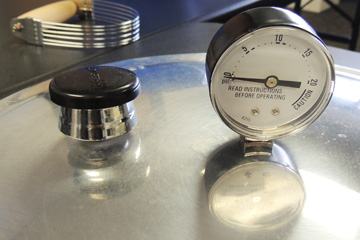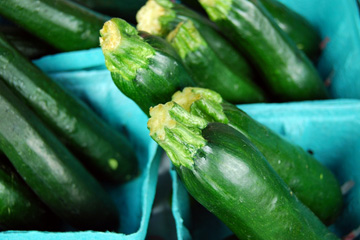
Test your Dial Gauge Canners Each Year

Summer is here, which means canning season is right around the corner. It is time to take inventory of your canning equipment.
Ensuring your pressure canner is in good condition and working properly is critical to produce safely canned products every year. There are two types of pressure canners, weighted gauge and dial gauge. The main difference between the two is the weighted gauge, in 5-, 10-, or 15-pound increments, rocks and jiggles to regulate pressure. The amount of weight used depends on the elevation of your location. The dial gauge uses a dial gauge to register the amount of pressure in the canner. You regulate the pressure by manually adjusting the stove burner.
If you have a dial-gauge pressure canner, it is important to get its accuracy checked each year. If the dial gauge is not registering the pressure correctly, the appropriate pressure may not be achieved, thus leaving the safety of your canned foods at risk.
There are a couple ways to get your dial gauge tested. Many Extension offices can test or know of hardware stores that have the equipment to test the accuracy of dial gauges. The canning company Presto will test Magic Seal, National, Maid of Honor, and Presto gauges at no charge.
It is recommended that dial gauge pressure canners be checked for accuracy every year to ensure safe, delicious, home canned foods all year round. Contact your local Extension offices for testing and assistance with your pressure canner.
Reference:
South Dakota State University Extension, https://extension.sdstate.edu/testing-dial-pressure-canner-gauges; April 11, 2022.
Preserving Zucchini and Other Summer Squash
Recommendations for canning summer squashes, including zucchini, that you may have seen in past United States Department of Agriculture (USDA) bulletins have been withdrawn due to uncertainty about the determination of processing times. Squashes are low-acid vegetables and require pressure canning for a specific period of time that will destroy the bacteria that causes botulism. Documentation for the previous processing times cannot be found and reports that are currently available do not support the old process. Slices or cubes of cooked summer squash will get quite soft and pack tightly into the jars. The amount of squash filled into a jar will affect the heating pattern in that jar. For more information, please see National Center for Home Food Preservation – Frequently Asked Canning Questions.
Freezing Zucchini is very simple. The technique you choose will depend upon how you will use it. To freeze grated zucchini for baking, the National Center for Home Food Preservation recommends:
- Choose young tender zucchini.
- Rinse with running water and trim ends. Scrub with a vegetable brush if needed. Grate squash.
- Steam blanch (directions below) in small quantities for 1 to 2 minutes until translucent.
- Pack in measured amounts into containers or freezer bags, leaving ½-inch headspace.
- Cool by placing the containers or bags in cold water.
- Seal and freeze. If watery when thawed, discard the liquid before using the zucchini.
To steam blanch: Use a pot with a tight lid and a basket that holds the food at least three inches above the bottom of the pot. Put an inch or two of water in the pot and bring the water to a boil. Put the vegetables in the basket in a single layer so that steam reaches all parts quickly. Cover the pot and keep heat high. Cover with lid and start counting steaming time.
To freeze sliced zucchini: Choose young squash with tender skin. Rinse with running water and trim ends. Scrub with a vegetable brush if needed. Cut into ½-inch slices. Water blanch (directions below) 3 minutes. Cool promptly, drain and package into containers or freezer bags, leaving ½-inch headspace. Seal and freeze.
To water blanch: Use one gallon water per pound of prepared vegetables. Place squash in blanching basket in small batches and lower into vigorously boiling water. Place a lid on the blancher. The water should return to boiling within 1 minute, or you are using too much vegetable for the amount of boiling water.
For more information, see: https://nchfp.uga.edu/how/freeze/squash_summer.html